Like most places the time of year can have a bearing on the species you are most likely to encounter if you want to target a particular species speak to one of our experienced guides prior to booking your trip to ensure you give yourself the best opportunity to catch that trophy fish.
Barramundi is the most sought after species and while they can be caught all year round they are best targeted in the hotter months this is also true of Mangrove Jacks Finger Mark and Salmon. The winter months produce the Pelagic species like Mackerel and Tuna. Queenfish and Trevally can be caught all year round.
Below is a description of the species of fish that may be found in Weipa as well as a chart designed to show you the best times of the year for different species of fish.
Black Jewfish
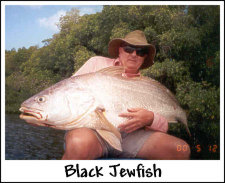
Scientific Name:Protonibea Diacanthus.
Also known as Black Jew, Spotted Croaker, Spotted Jew, Blotched Jewfish, Black Mulloway and Northern Mulloway.Description:The black mulloway is a large and prized northern mulloway species, growing to 40 kilograms and more than 1.5 metres.Fishing:
An excellent and highly prized species which frequents inshore reefs. The black jewfish has a powerful first run. While they can be taken on deep diving lures and jigs they are most often taken using fresh bait with best being large live baits or fresh cut or whole fish, squid or fresh large prawns. The black jewfish is a prized for its size, tenacity and eating qualities, which are excellent.
Minimum Size: 60cm
Bag limit: 2
Barramundi
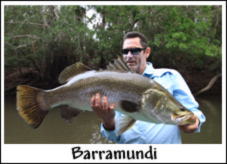
Scientific Name:
Lates Calcarifer: Also known as Barra.
Description:
The barramundi is a special fish, which is as beautiful in reality as it is in the dreams of so many anglers. It is the Barra that draws people to Weipa. It has a small head with a large mouth and large eyes, which glow bright red in torch light or at certain angles in daylight. Barramundi have large scales and a particularly powerful tail. Coupled with their thick shoulders, barramundi can put up a good fight. They are famous for gill arching leaps when hooked.
The barramundi can be a brilliant silver colour for sea run fish, ranging to a very dark, chocolate brown colour for fish in billabongs.
Barramundi in Australia change sex as they grow older. All fish start out as males and, after spawning once or twice, become female for the rest of their lives. This sex change is more related to age than size, but barramundi over 8 kg’s are almost certainly all female.
Fishing:
There are few thrills in fishing in Australia to match the thumping strike of a large saltwater Barramundi to a well cast lure or fly. Barramundi are classical ambush feeders and require some stream craft to be really successful. In tidal reaches, look for places which congregate food, especially on a dropping tide such as eddies or draining creek mouths. In freshwater, look for cover and cast close to or beyond likely looking snags, drop-offs or rock bars.
Minnow style lures like the Gold Bomber have been the most successful for barramundi for many years, but a supply of rattling spot lures and soft plastic jigs can also be deadly. Even when there is little or no surface activity, Barramundi can make a spectacular slashing strike at a surface lure. With many American and Japanese made lures, change the hooks, as a large barramundi can be lost through straightening hooks designed for smaller fish.
Increasingly anglers are fishing for barramundi with the fly. Flies such as Dahlberg divers and Deceiver patterns work very well and have the advantage of being able to be repeatedly placed very near to cover while drifting along a shore, teasing barra to strike. Many barramundi are taken on live bait. A common rig is to fish a live fish on the bottom of a large hole.
Minimum size: 58 cm Max 120 cm
ALL BARRAS OVER 80CMS CAUGHT ON OUR BOATS ARE RELEASED
Bag Limit: Maximum 5 fish in possession at any one time.
Cobia
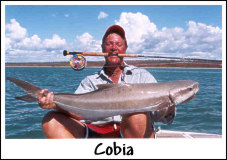
Scientific name:
Rachycentron Canadus. Also known as Cobe, Black Kingfish, Black King, Crab-eater, Sergeant Fish, Lemon Fish.
Description:
A large pelagic species reaching over 2 metres and 60 kilograms.
Frequently mistaken initially for a shark in the water due to its high dorsal fin and large, dark pectoral fins. They have a relatively pointy head with the mouth at the middle of the front of the head. They have a white or creamy belly, which tends to be darker around the anal fin region and a white stripe on their sides, which may fade after death. They also have very short dorsal spines before the high soft dorsal fin. Other fins, except pelvic are dark and the overall colour is chocolate brown to black.
Fishing:
Cobia are generally encountered opportunistically. They congregate around structures such as the marker posts in the channel leading into Weipa they are also renowned for travelling with manta rays and whale sharks. Many anglers chase manta rays to get a cast at these hard fighting, great tasting fish.
Cobia will take a variety of baits including squid, crabs and cut or whole fish. While frequently fished to with unweighted or lightly weighted rigs, they will take baits off the bottom, especially on sand patches near reefs. They can be cast to with lures or flies but can be difficult to catch in some sight fishing situations.
Minimum size: 75 cm
Coral Trout
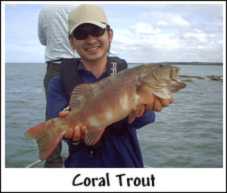
Scientific Name:
Plectropomus Leopardus. Also known as Leopard Cod, Leopard Trout, Trout and Blue-spot Trout.
Description:
The coral trout is frequently confused with other similar species, but the coral trout has numerous small and always round spots on the head and body. The colour varies but can be a brilliant red or red-orange or a brick red. The soft dorsal fin is rounded and the tail square cut which may have a blue edge. It has a large mouth and sharp but widely spaced canine teeth. The coral trout grows to over a metre and 20 kg, however most fish are taken at around 2 kg.
Fishing:
This is undoubtedly one of the premier reef fish due to its brilliant appearance, hard fight near coral outcrops and excellent eating. Coral trout can be taken on bait, lure and fly but fishing is typified by a short battle of strength and will between the angler and the coral trout. Best lures include minnow lures which dive to different depths, as coral trout will readily move upwards to slam a lure. Poppers can take some large fish. Coral trout, like many of the cod that are found in similar areas, can take large baits, with live baits being best.
The frequent presence of numerous sharp coral outcrops in many locations and a strong fish like the coral trout means that if the fish is given his head a break-off is certain.
Minimum size: 38 cm
Fingermark
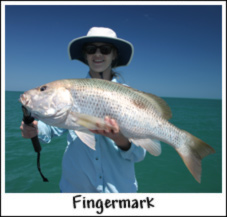
Scientific Name: Lutjanus Johnii. Also known as Fingermark Bream, Big Scale Red and Golden Snapper.
Description: The fingermark is a large sea-perch commonly taken from northern inshore reefs and estuaries. It has a speckled appearance because of a dark spot on each scale, which gives the appearance of parallel fine stripes. A large black blotch which varies in colour and intensity. Grows to 90 cm and more than 10 kilograms.
Fishing: This species has become a renowned deep diving lure taker. It can be taken on lures near the mouths of estuaries or rocky outcrops. They also take cut and whole fish baits well and provide excellent sport. Small schools of similar sized fish are frequently encountered. Fingermark are considered excellent eating.
Minimum size: 35 cm
Giant Trevally
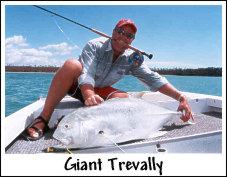
Scientific Name: Caranx Ignobilis. Also known as Lowly Trevally, Barrier Trevally
Description:
The Giant Trevally is the largest of the Trevally reaching 1.7 metres in 1 length and 60 kilograms which would be almost unstoppable on stand up fishing tackle. The steep profile of the head is typical of the Giant Trevally.
As giant trevally increase in size, they form smaller schools with the largest fish frequently loners. Large fish also prefer deeper channels between large reefs while smaller fish are found on tidal flats or on the edges of shallower reefs. I
Fishing:
Small giant trevally are one of the most challenging species for lure fishers in the tropics, with spinning near the edges of reefs, on drop-offs on tidal flats or sight fishing to individuals or small schools working well. Poppers are particularly attractive to these fish and can also be used as a teaser for fly fishers. Giant Trevally also take minnow lures, large spoons and lead-headed jigs. They are an avid taker of large fly’s and will certainly test the tackle and stamina of the angler.
Large Giant Trevally are most frequently taken on live baits. They will also take dead baits, including fresh dead baits, cut baits, pilchards or less frequently squid or large prawn baits. Giant trevally can be hooked when bottom bouncing with standard reef rigs for other species such as coral trout or various emperors, with arm stretching and tackle testing results.
Top quality gear and gel spun lines are an advantage in landing these challenging fish. Small giant trevally are good eating but fish over 10-12 kilograms are poor tasting and are better released after a photograph to record the encounter.
No size limit
Bag Limit: No limit but we encourage catch and release
Giant Herring

Scientific Name:
Elops Machnata. Also known as Pincushion-fish.
Description:
The giant herring is a beautiful, streamlined fish covered in small scales which are easily dislodged. This species is the largest of the true reaching 1.2 met and 11 kilograms, although it is frequently encountered at 1- 4 kilograms. The Giant Herring has a single dorsal fin. The giant herring has a very large upper jaw.
Fishing:
The giant herring is attracting increasing attention as its qualities as a sport fish are being recognised. Giant herring take trolled or cast lures such as small minnow lures readily and are a challenging proposition on the fly. Giant herring will also take live or fresh fish and prawns. Their spectacular leaps enhance their fight. The Giant Herring is full of fine bones, which make them a very poor table fish. Their loose scales mean they need to be carefully handled to survive release.
Minimum size: N/A
Mangrove Jack

Scientific Name:
Lutjanus Algentimaculatus. Also known as Jacks, Red Bream.
Description:
The mangrove jack is best known for its destruction of fishing tackle in tidal creeks, but these tend to be juvenile or small adult fish. The largest specimens are taken in offshore reefs at a depth of 100 metres. Mangrove Jacks can reach more than 1.2 metres and a weight of 15 kilograms but fish in inshore waters are a real handful at 1 -3 kilograms. The Mangrove Jack is often confused with the red bass, a much more notorious ciguatera species. The Mangrove Jack has a taller dorsal fin, a lack of lengthwise stripes on its side and the absence of black on fins. Mangrove Jacks lack the distinctive pit before the eye of the red bass which is predominantly a coral reef species.
Fishing:
Mangrove Jacks are the toughest and dirtiest fighters in Australian waters. They will dash out and engulf a lure or bait and break off an unwary angler on the nearest snag before they realise the strike has been made. As a result, mangrove jacks require quality, well maintained gear and tight drags. They can destroy cheap equipment as they dive into snags.
Mangrove Jacks like tough dirty cover although they can be found in deeper holes in tidal waters where they are a bit easier to handle. Diving lures, spinner baits, jigs and flies work well for jacks. They will take cut or whole fish baits, prawns, crabs and especially live baits. The strike is savage and a prelude to the action to come.
Mangrove Jacks should be handled carefully as their dorsal spines can create a nasty wound, especially on water softened hands. Jacks can also take a nip at fingers while being unhooked, but they are a hardy fish which survives handling well. The mangrove jack is good eating but in offshore waters should be carefully identified as red bass are a dangerous ciguatera species.
Minimum size: 35 cm
Snub-Nosed Dart

Scientific Name:
Trachinotus blochii Also known as Oyster Cracker, Dart, Permit.
Description: The snub-nosed dart has characteristic orange or yellow colouration of the ventral and anal fins. This fish has quite a small mouth and the nose is rounded. The eye is quite large and close to the mouth. The snub-nosed dart can reach a size of 65 cm and more than 9 kilograms.
Fishing:
These fish are most often taken on a rising off ocean beaches. They are gaining notoriety as a premier sports fish they are a rare but prized catch on a fly. The snub-nosed dart is excellent eating to match the fantastic sport, which these fish provide.
Minimum size:
Bag Limit: Catch and release only
Queenfish
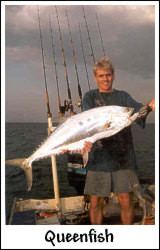
Scientific Name:
Scomberoides commersonnianus. Also known as Giant Leatherskin, Leatherskin, Queenie, Skinny, Skinnyfish.
Description:
The Queenfish is a large, long and laterally compressed species, which leads to the common name of Skinny and a lightweight for the length. The mouth is large. A series of 5 to 8 oval shaped blotches are found on the sides above the lateral line. The Queenfish also has a prominent, high and light coloured front part of the dorsal and anal fins. These fish have lance shaped scales which are deeply embedded in a leathery skin. The Queenfish can reach 120 cm and more than 11 kilograms.
Fishing:
Queenfish are found from the upper tidal reaches of tropical rivers to inshore reefs and occasionally near outer reefs which have shallow breaks. Queenfish prefer slightly turbid water with plenty of flow. They are ambush feeders and will lurk near cover such as eddies, rock bars, wharves and creek mouths, especially on a falling tide. Queenfish are spectacular and exciting sportfish, with their slashing strikes and blistering runs, often with aerial displays. Queenfish will take dead baits such as mullet, pilchard, garfish, mudskippers, whiting or fresh prawns and squid. They are also partial to live bait. Queenfish are renowned lure takers, with cast or trolled lures such as sliced chrome lures, shallow and deep diving minnows, spinner baits and surface lures. Queenfish are excited by escaping baitfish, so a fast, erratic retrieve is most successful. Fly enthusiasts are increasingly targeting Queenfish as they are an exciting challenge on light fly gear. Large minnow type flies retrieved through current eddies on a fast strip works best. A heavy monofilament leader is recommended when fishing for Queenfish as their jaws and small teeth can damage light traces.
The Queenfish is an under-rated food fish, mainly because they are often caught in conjunction with Barramundi and Threadfin Salmon which are excellent food fish. Like all tropical fish, the quality of Queenfish is improved with immediate bleeding and placing in an ice brine slurry.
Minimum size: 50 cm
Threadfin Salmon

Scientific Name:
Polydactylus sheridani. Also known as Blue threadfin, Burnett Salmon, King Salmon.
Description:
The Threadfin Salmon possesses 5 long, distinctive fingers on the lower edge of the pectoral fin. This species has a more pronounced blue colour and along and relatively narrow caudal wrist. The Threadfin Salmon is common between 0.5 and around 3 kilograms with occasional specimens slightly larger.
Fishing:
The Threadfin Salmon is a commonly caught while luring for Barramundi taking small bright lures (pink seems to be a favourite colour), shiny minnow lures and salt-water flies. This species also prefers fresh bait with a white or silver sheen as well as prawns or crab baits. The Threadfin Salmon is an excellent eating species, which should be cleaned quickly and eaten fresh.
Minimum size: 60 cm
Tarpon
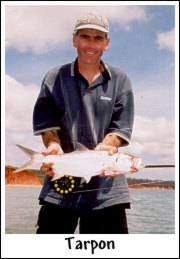
Scientific Name:
Megalops cyprinoides. Also known as Ox eye herring.
Description:
The tarpon is most easily identified by the long trailing filament at the rear of the single dorsal fin. The eye is also very large, as are the upper jawbones. The tail is deeply forked and powerful. The scales are very large.
Tarpon are commonly found in mangrove creeks, larger estuaries and bays. The tarpon can grow to around 3.5 kilograms although most fish are taken at around 1-2kg.
Fishing:
The tarpon will take dead fish bait but can be very finicky. They can sometimes be taken on small live baits. However, tarpon are a fantastic fighting fish and are a target species for lure and fly fishers. Most fish are taken on small white jigs or small chrome lures. They are also avid fly takers. The mouth of the tarpon is bony and hooks should be at their absolute sharpest to get a solid hook-up that can survive the strong fight and aerial display of the tarpon. A heavy nylon trace is recommended as Tarpon small sandpaper type teeth, which will easily wear thin lines. Tarpon are extremely bony and are considered poor eating. Care should be taken with handling to reduce scale loss and long term mortality of released fish.
Minimum size: N/A
Bag Limit: N/A but we encourage catch and release
Triple Tail
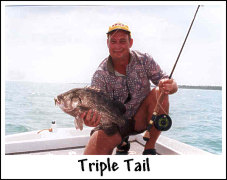
Scientific Name:
Lobotes surinamensis. Also known as Jumping Cod.
Description:
The TripleTail is a reasonably large predator of mangrove creeks, estuaries and inshore reefs that can reach 1 metre and around 11 kilograms but is more common at smaller sizes.
The most obvious feature is the elongated soft dorsal and anal fins which gives the resemblance of three tails.
The base colour varies from yellow in small juveniles to chocolate brown with a silvery sheen and there may be grey mottling.
The eye is relatively small and the mouth is also fairly small finishing in front of the eye.
Fishing:
The TripleTail is a very strong fighter, with the surface area of the Triple Tails providing significant leverage. The Triple Tail can also be a strong jumper.
The TripleTail is commonly found near drop-offs in mangrove creeks or near pylons, anchor chains or other structures in estuaries that they can use to advantage. Triple Tails take lures well, particularly minnow lures, slices and jigs. They are also great sport on flies. They will also readily take fresh cut baits, pilchards or small live baits. The TripleTail is excellent eating and many rate this species above Barramundi.
Minimum size: N/A
Bag Limit: We encourage catch and release
Longtail Tuna

Scientific Name:
Thunnus tonggol. Also known as Northern Bluefin Tuna, Northern Blue and Blue Tuna.
Description:
The name Longtail comes from the light build to the rear half of this species, giving a narrow tail wrist and a slender outline. The pectoral fin is very short and finishes well in front of the start of the second dorsal fin, which readily separates the species from Yellowfin and Bigeye Tuna. This species is much more common in tropical waters but can migrate southwards in summer.
Fishing:
In tropical waters, small Longtails can form vast schools like Mackerel Tuna or Bonito. These schools will eagerly accept Minnow lures, lead slugs or Christmas tree lures, feather jigs, spoons and flies all work well with larger fish preferring larger lures and fly’s and a faster retrieve, a double hand retrieve is most effective when fly fishing. Care should be taken when approaching a school as they are easily spooked.
Longtail Tuna are red fleshed and of lower quality than many species, but it is greatly improved with immediate bleeding.
Minimum size: N/A
Bag Limit: N/A but we encourage catch and release.
Saratoga
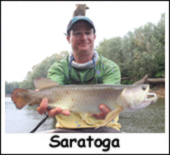
Scientific Name:
Scleropages jardinii. Also known as Northern saratoga, Northern Spotted Barramundi, Bony Tongue.
Description:
A primitive species obviously designed for feeding close to the surface, the Saratoga has a relatively straight dorsal profile. The gulf Saratoga has a large upturned mouth which extends beyond the back of the large eye. A single small barbel is found under the lower lip. The dorsal fin is set well back and commences well behind the anal fin. The pectoral fins are large and set low down on the body. The dorsal, anal and tail fins are dark with many small red spots and the scales have curved red bars. The Saratoga prefers clear streams and faster flowing upper reaches of streams but can adapt to impoundments.
Fishing:
The Saratoga is a surface and midwater feeder which will consume insects, small fish and crustaceans. While they will take small lightly weighted baits such as shrimps and small frogs, they are most highly regarded as lure and fly targets. The Saratoga is a fantastic fish on the fly, taking deceiver and Dalhberg diver flies well. Surface lures such as jerk baits, poppers work very well. The bony mouth can make setting the hook difficult and many lures are thrown on the jump. Saratoga can reach 90 cm and more than 17 kilograms, but most fish caught are between 50 and 65 cm in length. The saratoga is a very poor table fish and should be released to provide sport for the future.
Minimum size: 50cm
Bag Limit: 1 We recommend catch and release only.
Spanish Mackerel
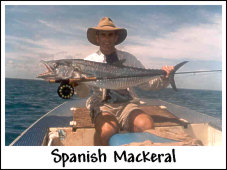
Scientific Name:
Scomberomorus semifasciatus. Also known as Narrow-barred Spanish Mackerel, Blue Mackerel, tanguigue, Spaniard,Seer, Seerfish.
Description:
The Spanish mackerel is a highly sought after and valued species capable of reaching 2.35 metres and 42 kilograms. It is commonly taken from 5 -15 kilograms. Smaller fish travel in pods of similar sized fish. The Spanish mackerel is similar to the Wahoo but has fewer dorsal spines (15 -18 versus 23 -27) in a shorter dorsal fin. The upper jaw of the Spanish mackerel has an obvious external bone which extends to at least the middle of the eye, while in the wahoo there is no obvious bone and the upper jaw extends to the front edge of the eye. The Spanish mackerel is found in coastal waters, frequently in the vicinity of reefs.
Fishing:
One of the most prized tropical pelagic species, particularly as it can be taken from relatively small boats. Spanish Mackerel will aggressively take trolled lures and baits. Minnow lures, spoons and feathered lures run at 5 -7 knots work best, while trolled garfish, slimy mackerel or other fish at 3 -5 knots will take good catches. Spanish mackerel will also take drifted live, whole or cut baits. They will also aggressively attack flies. A wire trace can be an effective counter to the sharp teeth of the Spanish mackerel, although there are few bite-off with lures which are attacked from behind.
The Spanish mackerel is an excellent sport fish, particularly on light line, as it runs strongly and occasionally jumps in its attempts to escape. Spanish mackerel can actively feed at different depths, so lures and baits which target a wide range will more quickly locate fish.
The Spanish mackerel is a highly regarded food fish, but does not freeze particularly well, especially if cut into steaks. The quality is much better when the fish is filleted.
Minimum size: 75cm
Bag Limit: 3
Information on the fish species was derived from The Australian Fishing Network, Australian Fish Guide by Frank Prokop.
